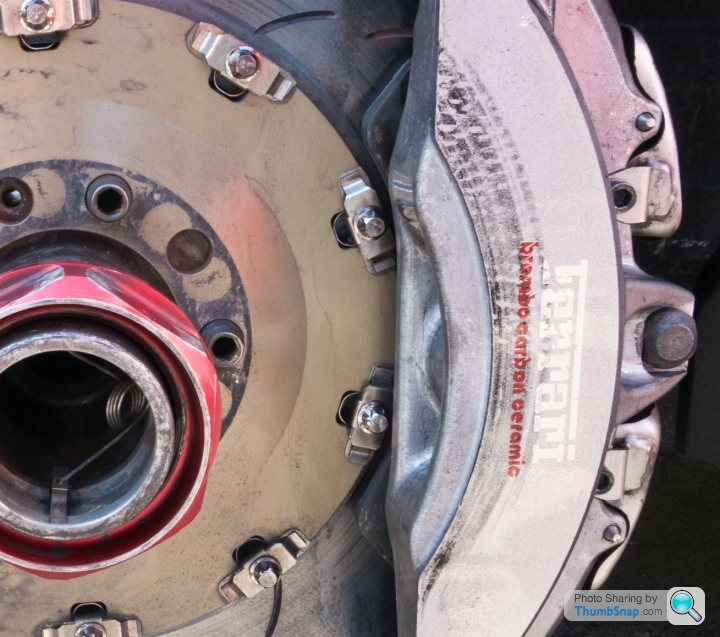Problem of premature failure of PCCB ceramic brakes
Discussion
Let me post some nice brake pics that I took at VLN 1 (German Endurance Racing Championship) at Nurburgring on 29 March to ease the tension building up here.
The brakes are mostly from SP8 and SP9 class cars such as SLS, R8, 911R, 911 Cup, Ford GT, 458, etc. You will see a mix of steel and ceramic brake kits though more ceramic than steel on these top classes.
If you would like to see them all, full set are here: http://s1015.photobucket.com/user/dodoracing/libra...

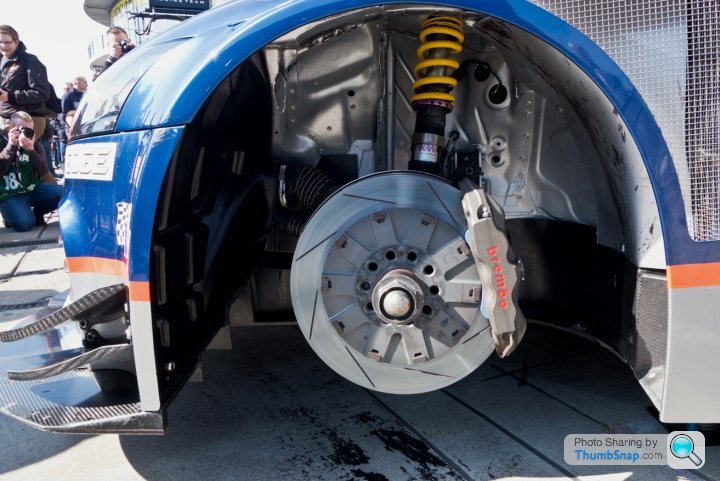
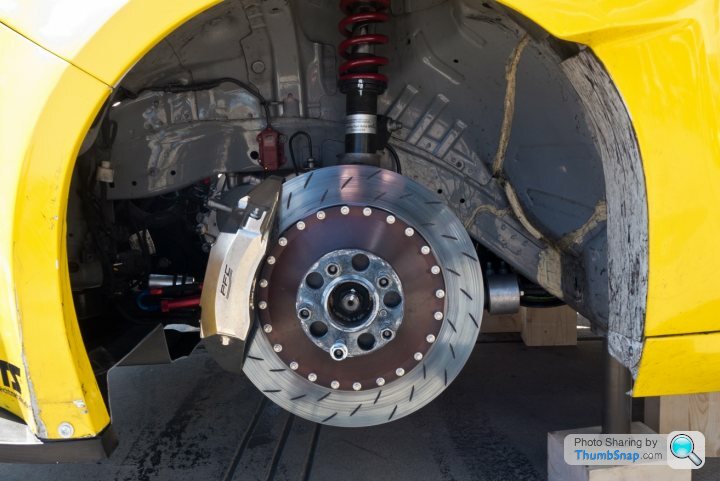
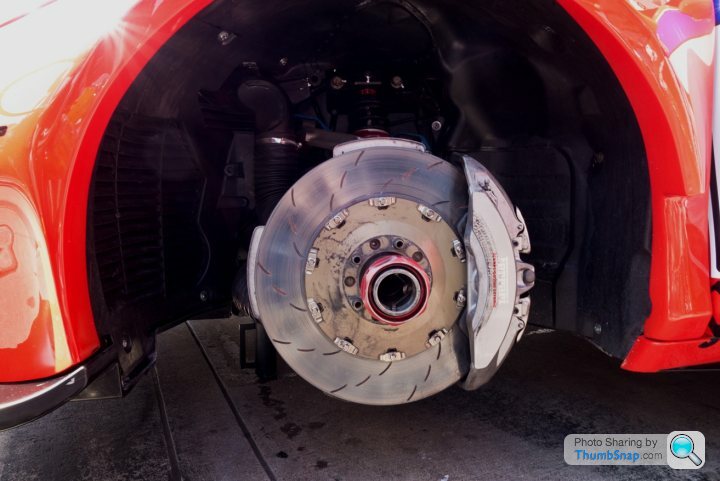
The brakes are mostly from SP8 and SP9 class cars such as SLS, R8, 911R, 911 Cup, Ford GT, 458, etc. You will see a mix of steel and ceramic brake kits though more ceramic than steel on these top classes.
If you would like to see them all, full set are here: http://s1015.photobucket.com/user/dodoracing/libra...




As a slight tangent, some of you may have noted the different fixing setups utilized on the various two piece rotors on the cars above. The proper brembo racing setup with the heavy duty hardware that can be seen on some of the cars is fantastic.
Not only does it let there be complete floating but the hat life is much better whilst hat failure is removed almost completely. With the regular fixing type that is used on street 2 piece rotors and some of the ones in the pictures the holes elongate with use and you need to bin the hats regularly.
heres a pic of one of my rotors where you can see the mounting setup I am on about. The openings in the hats are just U shaped notches, the hardware just slots in.
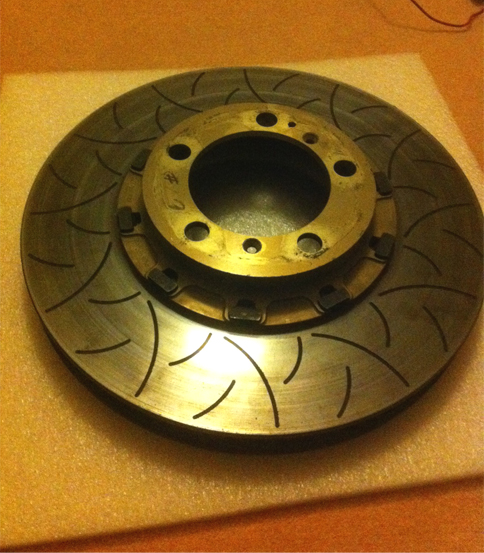
Not only does it let there be complete floating but the hat life is much better whilst hat failure is removed almost completely. With the regular fixing type that is used on street 2 piece rotors and some of the ones in the pictures the holes elongate with use and you need to bin the hats regularly.
heres a pic of one of my rotors where you can see the mounting setup I am on about. The openings in the hats are just U shaped notches, the hardware just slots in.

Edited by fioran0 on Sunday 13th April 23:16
Harris_I said:
I think you have not got the hang of this Pistonheads thing, Neil. Best not to focus on facts which are empirically provable. May I suggest you take your trousers off and sit in front of your PC shouting loudly at other internet users.
If people want to buy ceramic brakes, let them spend their several grand on the biggest con trick perpetuated by premium manufacturers since the optional £2000 satnav that is outperformed by a £100 hand held device.
I fully agree if people want to buy ceramic brakes, they should feel free to go ahead. For their several grand they'll get brakes that don't corrode, have very little brake dust, are quiet in operation, and IMO feel much better than steels.If people want to buy ceramic brakes, let them spend their several grand on the biggest con trick perpetuated by premium manufacturers since the optional £2000 satnav that is outperformed by a £100 hand held device.
The relative performance doesn't interest me one way or the other for road driving, both systems are more than adequate.
Surely it's good to have the choice, they have great benefits for some, for others steels are the best option.
fioran0 said:
As a slight tangent, some of you may have noted the different fixing setups utilized on the various two piece rotors on the cars above. The proper brembo racing setup with the heavy duty hardware that can be seen on some of the cars is fantastic.
Not only does it let there be free floating but the hat life is much better whilst hat failure is removed almost completely. With the regular fixing type that is used on street 2 piece rotors and some of the ones in the pictures the holes elongate with use and you need to bin the hats regularly.
heres a pic of one of my rotors where you can see the mounting setup I am on about.

Back to road cars for a second, gen2 gt3 with c/l has drive pins so i assume its never going to elongate the holes on the hats?Not only does it let there be free floating but the hat life is much better whilst hat failure is removed almost completely. With the regular fixing type that is used on street 2 piece rotors and some of the ones in the pictures the holes elongate with use and you need to bin the hats regularly.
heres a pic of one of my rotors where you can see the mounting setup I am on about.

ChrisW. said:
At the very least, how many sets of steels would have been consumed in the time taken to destroy one set of PCCB's ?
Depends upon the car, driver and circuit. Anecdotally (from people that I have met/cars that I have seen) on a 911 a set of PCCB can last anywhere between 4 and ~20 days. Steel will typically last between 12 and 30 (though OE drilled disks are often binned early due to fractures around the vent holes). Unless it is the Nurburgring of course - relative to shorter circuits, disks last far longer there.Whatever your point is - however - I am missing it.
On normal road use things are different though. PCCB should last 100000+ miles if user reports and the widely known historic boundary cases (the 180k miles original PCCB car and so on) can be assumed to hold. Which maybe makes sense if you spec from new, but if you have to replace them then they are ~7 times the price of steel and the numbers still don't really work.
With alternatives such as Surface Transforms which are able to offer (allegedly even superior quality) replacements at affordable prices (I was quoted around 7k for all-round continuous carbon fibre discs + pads) then surely Carbon brakes will be less of a catastrophe if they ever need replacement...
The only issue with this is the extended warranty one.. which forces you to stick with Porsche parts going against the very spirit of the EU laws which had sanctioned that manufacturer warranties cannot be voided by using same-quality alternative components in order to increase competition.
Porsche, Ferrari & the likes of course get around it by accepting it for manufacturer warranty and then banning them for extended.. preventing people from using the components in the first place....
Still if you can live without warranty (I think some of the specialists offer alternatives anyways..) then PCCB become a more sensible proposition.
The only issue with this is the extended warranty one.. which forces you to stick with Porsche parts going against the very spirit of the EU laws which had sanctioned that manufacturer warranties cannot be voided by using same-quality alternative components in order to increase competition.
Porsche, Ferrari & the likes of course get around it by accepting it for manufacturer warranty and then banning them for extended.. preventing people from using the components in the first place....
Still if you can live without warranty (I think some of the specialists offer alternatives anyways..) then PCCB become a more sensible proposition.
Sandy59 said:
I fully agree if people want to buy ceramic brakes, they should feel free to go ahead. For their several grand they'll get brakes that don't corrode, have very little brake dust, are quiet in operation, and IMO feel much better than steels.
The relative performance doesn't interest me one way or the other for road driving, both systems are more than adequate.
Surely it's good to have the choice, they have great benefits for some, for others steels are the best option.
+1The relative performance doesn't interest me one way or the other for road driving, both systems are more than adequate.
Surely it's good to have the choice, they have great benefits for some, for others steels are the best option.
Having had PCCB's, I now couldn't go without them.
DiscoColin said:
Depends upon the car, driver and circuit. Anecdotally (from people that I have met/cars that I have seen) on a 911 a set of PCCB can last anywhere between 4 and ~20 days. Steel will typically last between 12 and 30 (though OE drilled disks are often binned early due to fractures around the vent holes). Unless it is the Nurburgring of course - relative to shorter circuits, disks last far longer there.
Whatever your point is - however - I am missing it.
On normal road use things are different though. PCCB should last 100000+ miles if user reports and the widely known historic boundary cases (the 180k miles original PCCB car and so on) can be assumed to hold. Which maybe makes sense if you spec from new, but if you have to replace them then they are ~7 times the price of steel and the numbers still don't really work.
I completely agree. So why not replace with steel if you damage them ?Whatever your point is - however - I am missing it.
On normal road use things are different though. PCCB should last 100000+ miles if user reports and the widely known historic boundary cases (the 180k miles original PCCB car and so on) can be assumed to hold. Which maybe makes sense if you spec from new, but if you have to replace them then they are ~7 times the price of steel and the numbers still don't really work.
Just because I disagree with Jimmy, why should I work for Porsche ?
Jimmy, why should you feel that a contrary view should be anything other than honest ?
I do not attack you, I disagree with you.
Fit PCCB's new and if you trash them, replace with steel.
Any normal person would.
But Jimmy appears to want to replace with PCCB and then ask Porsche to pay for them ??
Correct me if I am misunderstanding ...
Brakes are consumables ...
that's what i always thought.
but now,, ... i keep saying we have a better alternative than steels.
Movit CER.. will upgrade my PCCB to the next size up for under 11k all round and Alcons from JZM are significantly less. what's there not to like.
if the PCCBs on my RS or spyder wear out, i'm going with these babies.........
but now,, ... i keep saying we have a better alternative than steels.
Movit CER.. will upgrade my PCCB to the next size up for under 11k all round and Alcons from JZM are significantly less. what's there not to like.
if the PCCBs on my RS or spyder wear out, i'm going with these babies.........
This thread seems to have run its course. So I would like to thank everyone for their contribution.
As a final comment, I’d like to clear up a misconception some responders seemed to have. My motive was never about my warranty dispute with Porsche. That issue is water over the dam. Instead, my purpose has been to try to determine how widespread is the failure of PCCB rotors and also to alert others of the risks associated with them.
As for me, my path is clear. A pair of replacement PCCB rotors cost $8000. The same rotors in steel are around $400. In my mind, PCCB are not 20 times as good as steel. Therefore, I intend to vote with my checkbook. Until Porsche installs brake temperature sensors and an on-off switch for torque vectoring, I intend to take my business elsewhere.
Porsche’s competitors already offer or will soon release some worthy alternatives; e.g. Jaguar F-type, the next generation Audi R-8 and McLaren 650S and P13. I am particularly excited about the Mercedes-AMG GT. Its interior looks stunning (http://tinyurl.com/mxmv5pj)
As a final comment, I’d like to clear up a misconception some responders seemed to have. My motive was never about my warranty dispute with Porsche. That issue is water over the dam. Instead, my purpose has been to try to determine how widespread is the failure of PCCB rotors and also to alert others of the risks associated with them.
As for me, my path is clear. A pair of replacement PCCB rotors cost $8000. The same rotors in steel are around $400. In my mind, PCCB are not 20 times as good as steel. Therefore, I intend to vote with my checkbook. Until Porsche installs brake temperature sensors and an on-off switch for torque vectoring, I intend to take my business elsewhere.
Porsche’s competitors already offer or will soon release some worthy alternatives; e.g. Jaguar F-type, the next generation Audi R-8 and McLaren 650S and P13. I am particularly excited about the Mercedes-AMG GT. Its interior looks stunning (http://tinyurl.com/mxmv5pj)
HokumPokum said:
that's what i always thought.
but now,, ... i keep saying we have a better alternative than steels.
Movit CER.. will upgrade my PCCB to the next size up for under 11k all round and Alcons from JZM are significantly less. what's there not to like.
if the PCCBs on my RS or spyder wear out, i'm going with these babies.........
Has anyone here have experience of using the movit ceramics? Have heard pretty good things about them.but now,, ... i keep saying we have a better alternative than steels.
Movit CER.. will upgrade my PCCB to the next size up for under 11k all round and Alcons from JZM are significantly less. what's there not to like.
if the PCCBs on my RS or spyder wear out, i'm going with these babies.........
The steels available for the 911 - brembo. Alcon et al - are so good that the limiting factor is tyre grip and not braking capacity. This is true of most racing cars until they benefit from a high downforce aero package and slicks such as the larger single seat series and LMP1. Until you are driving something with these levels of grip, ceramic brakes as a marginal performance benefit is minimal at best.
Gassing Station | Porsche General | Top of Page | What's New | My Stuff



